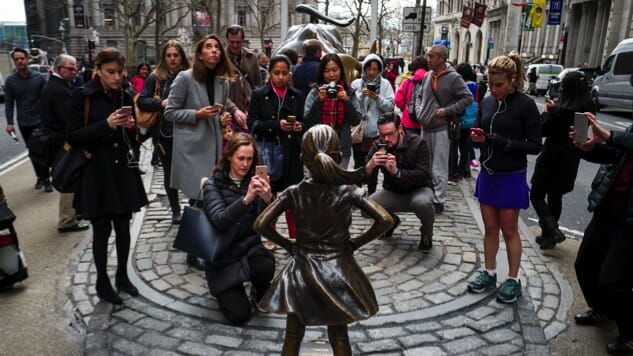McResistance: Why the Liberal Preoccupation With Symbolic Victory Alienates Us From Politics
Photo by Drew Angerer
Liberal politics have become disproportionately concerned with the symbolic. In part, this is a reaction to the slow loss of influence of liberal politicians in the American government at the national and state levels. When the avenues for legislative change narrow, people will find alternatives, and liberalism has found one avenue in the symbolic. Principal in this move is the alienation of the average American’s political life from the material reality of political decisions. Not only do most people feel disconnected from goes on in Washington, the liberal expression of politics is unable to bridge the gap—and, at its worst, only increases this alienation.
This is no better expressed than the sale of McDonald’s themed t-shirts and apparel under the banner, “Supersize the Resistance,” in response to a tweet by the corporate McDonald’s account that called Trump a disgusting president. The apparel carries several slogans such as “vive la résistance” imposed over fast food or the image of Ronald McDonald’s fist raised in solidarity—notable that it is the mascot’s fist raised in solidarity and not that of, say, a fictionalized employee. The imagery is the explicit merger of the language of resistance with that of global capitalism. Political action is reduced to another commodity on the market.
The striking thing about this commodification of “resistance” is that it is not a lone example. Whether it is the infamous $300 safety pin, Chelsea Clinton publishing a book titled She Persisted or the fact the much-celebrated fearless girl statue is a marketing stunt for an investment firm, liberal resistance has been market friendly. Here resistance becomes another product paradoxically upholding the status quo rather than challenging it. Wall Street’s problem isn’t that the financial industry explicitly profits off others poverty, they just need more women as board members. McDonald’s hasn’t fought paying employees a living wage—it’s part of the resistance. That liberalism is largely uninterested in challenging the status quo makes this emphasis on the symbolic necessary.
If resistance to Trump is to be meaningful, it should stand for more than symbolic victories and, thus, oppose more than just Trump in isolation. Horrific actions under the Trump administration are rightly condemned but it is rarely asked how such actions were made possible in the first place. Trump’s decision to okay a raid in Yemen that largely saw only the slaughter of children was rightly condemned, but there were no mainstream pundits asking why the US was in Yemen in the first place. The increased autonomy surrounding ICE and their deportation practices are documented in all their barbarity and horror—but why a de facto deportation force existed at day-one of Trump’s presidency is seldom explored.
-

-

-

-

-

-

-

-

-

-

-

-

-

-

-

-

-

-

-

-

-

-

-

-

-

-

-

-

-

-

-

-

-

-

-

-

-

-

-

-








































